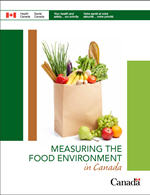Archived Measuring the Food Environment in Canada

The food environment includes features of the community, such as the number and kinds of food outlets in people’s neighbourhoods, which is often referred to as geographic food access. It also features the consumer experience, such as the kinds of foods that are available, affordable, and of good quality. Many jurisdictions in Canada have begun to act on food environments. Some have restricted geographic access to certain kinds of food outlets (such as fast-food outlets or convenience stores) where non-nutritious foods are readily available. Others have created incentives for food outlets where nutritious foods are readily available, such as farmers' markets and grocery stores.
Research on the food environment is relatively new, and the conflicting evidence to date dictates caution when implementing policies or programs that aim to improve food environments. That said, the field of research is promising and deserves attention and investment from a public policy perspective. Environmental factors have the potential for a more sustained impact on health outcomes than programmatic strategies. More research in this area will help to inform the creation of effective, sustainable solutions to improve healthy eating in Canada.
By means of a literature synthesis, this report discusses the conceptual models and measurement approaches currently in use in research on food environments. It examines their application to the Canadian context and the evidence available to date on the association of food environments with diet-related outcomes. The report points out unresolved issues and gaps in the existing research methodology, with an emphasis on research approaches needed to address uniquely Canadian food environments, such as in the North.
The report then takes a closer look at the Canadian context, with a review of 19 Canadian community food assessments. Through interviews with key informants across Canada, the report highlights the experiences and analysis of food researchers in communities across the country. It examines in detail three case studies of notable food environment measurement initiatives within different Canadian contexts.
Here are the report's key findings:
- Most of the Canadian literature published to date shows associations between features of the food environment and residents’ diet-related outcomes, even after adjusting for important confounding variables.
- In the academic literature, there is not much evidence for the widespread existence of food deserts in Canada - areas where vulnerable populations have poor geographic access to nutritious food. But there is evidence for the existence of food swamps - areas of low socioeconomic status with high geographic access to non-nutritious food sources.
- The review of Canadian community food assessments and the key informant interviews showed that food deserts may be more common than has yet been identified in the academic literature. This reveals the importance of collecting evidence from a variety of sources.
- Food swamps - neighbourhoods where sources of high-fat, high-calorie foods were plentiful, were fairly consistently identified in the community food assessments, and may be more important than food deserts in influencing residents’ diets.
- There is not enough information about food environments in remote northern communities. This is a significant research gap, because rates of food insecurity and diet-related chronic diseases are much higher in these communities than elsewhere in Canada.
- There are many food environment assessments underway in Canada. Community-university partnerships can be an ideal way to conduct research that can be used for policy and program development.